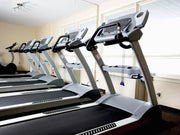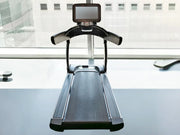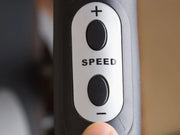Treadmills are a great way to stay in shape, but misusing them can cause discomfort or even lead to accidents. Fitness experts and treadmill manufacturers recommend following proper positioning guidelines to make your workout safer and more effective. Here's what you need to know about walking or running on a treadmill the right way.
1. Proper Body Positioning
-
Stay Centered: Position yourself in the middle of the treadmill belt to maintain balance and avoid stepping too close to the front or back.
-
Keep a Safe Distance from the Console: To prevent accidental collisions, maintain about 8 to 12 inches (20 to 30 cm) of space between you and the treadmill console.
-
Avoid the Edges: Running too close to the sides of the treadmill can increase the risk of slipping.
2. Using the Handrails Correctly
-
Handrails Are for Balance, Not Support: While they can help in emergencies, constantly holding onto the handrails can cause poor posture and unnatural gait.
-
Develop Stability First: Beginners may lightly touch the rails to build confidence, but they should strive for hands-free, natural movement.
3. Maintaining Good Posture
-
Keep Your Head Up: Look forward, not at your feet, to maintain proper spinal alignment.
-
Relax Your Shoulders: Keep them down and avoid tensing up.
-
Maintain a Natural Arm Swing: Let your arms move freely, as they would during outdoor walking or running.
-
Engage Your Core: Keeping your core tight can improve stability and reduce strain on your lower back.
4. Adjusting Settings for Safety
-
Start Slow: Always begin at a comfortable pace before increasing speed.
-
Use the Safety Key: Attach the safety clip to your clothing to automatically stop the treadmill in an emergency.
-
Gradually Slow Down Before Stopping: Reduce speed before stepping off rather than abruptly stopping.
Follow these guidelines and maximize safety while using a treadmill. Proper positioning ensures an injury-free experience.
Parts and Maintenance: How to Prevent Treadmill Accidents
Proper treadmill maintenance is essential for safety, as certain parts can risk falling if not kept in good condition. Here are the key areas to check:
1. Treadmill Belt
-
If the belt is worn out, loose, or misaligned, it can cause slips or trips.
-
A poorly lubricated belt may create jerky movements, making it harder to maintain a natural stride.
2. Motor and Drive System
-
A faulty motor can unexpectedly change speed, increasing the risk of losing balance.
3. Deck and Shock Absorption
-
If the treadmill deck is cracked or the cushioning is worn out, it may become unstable while running or walking.
4. Handrails and Frame
-
Loose or unstable handrails may fail to provide proper support if you need to grab them quickly.
5. Control Panel and Sensors
-
A malfunctioning control panel with unresponsive buttons or faulty sensors can make it difficult to stop the treadmill safely.
6. Safety Key
-
If the safety key is damaged or not properly attached, it may not function correctly in an emergency.
Pro Tip:
Regular inspections and maintenance can help prevent these issues and ensure safe treadmill walks and runs.
Need a specific part to replace on your treadmill? Visit our website to find replacement parts that will eliminate fall risks. Don't put your safety on hold!







